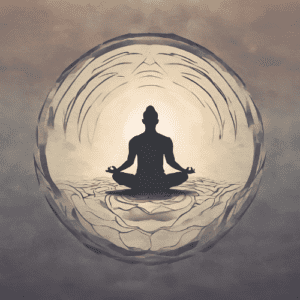BASIC MEDITATION
Where did meditation come from?
It’s unknown where meditation originated from. But the Hindu Vedas texts are regarded to be the oldest source of the practice, dating as far back as c1,500 BC. The ancient Indians likely mainly used meditation as a religious practice in early Hinduism and Buddhism. However, it is believed that similar practices emerged independently in various regions around the world, such as Ancient China, Greece, and the Middle East. By the 20th-century, meditation practice saw a boom in popularity in the western world due to increased globalisation and cultural exchange. From here, the practice became secularised, and its therapeutic benefits recognised in healthcare and psychology settings. The practice therefore is not restricted to the religious and is accessible to all people regardless of personal belief. In this article, I will attempt to outline some of the ideas behind meditation, and give you some steps to practice a basic form of the practice.
The ideas behind the practice
But sometimes our environment can negatively effect our consciousness, especially when it comes to negative experiences. For example, if a rabid dog attacked you at a young age, you would understandably develop a fear or a phobia towards unfamiliar dogs. Now your mind filters your consciousness based on that past experience in the interest of self-preservation, regardless of the behaviour of any dogs you may come across in day-to-day life. On one hand this process is reasonable, and served as a necessary survival mechanism to our ancestors who were in constant danger. You could even argue that humanity has survived as long as it has because of the trauma, fear and stress caused by our environment. But this psychological conditioning can lead to a great deal of unnecessary suffering if your consciousness becomes overly tempered by your negative life experiences, and can quite easily leave you in a state of fear and anxiety. And sometimes we develop this conditioning automatically based on perceived threats rather than realistic threats. The point is we all develop psychological conditioning on some level and that’s okay.
The current state of consciousness
This describes the current state of consciousness for a lot of people people. The limitations of both our psychological conditioning and our physical bodies causes us to experience this tempered, narrow range of consciousness. But what if it was possible to remove these conditions and experience a broader range of consciousness? We already experience a level of this through dreaming. When we dream, the limitations of the body are removed temporarily, allowing for an abnormal state of consciousness to be assumed, although our dreams are still affected by our conditioning and tend to reflect our mental state. But removing our conditioning can allows us to perceive day-to-day reality more clearly. When the consciousness is free of filters and influences, it becomes easier to see and understand reality for what it is. This is what meditation is intended to help achieve.


Meditation 101
With all of this in mind, let’s explore an easy way to enter a state of meditation. We will call this technique “breath meditation”.
- First, sit in a comfortable upright position on a chair or on the floor.
- Relax your body. One way to do this is to take deep breaths and try to relax different parts of your body from head to toe each time you exhale.
- As you inhale, visualise the air you breathe in filling up your stomach rather than your lungs. We call this “belly breathing”, and it helps expand the diaphragm, allowing you to breathe more deeply.
- Now focus your attention on your breathing. This is to ground you in the present, as the process of breathing only occurs in the present moment.
- As you sit, let your mind wonder. Every now and then a thought will pop into your head. But instead of dwelling or thinking about it, simply let it pass and remain focused on your breathing.
- Now it is important to avoid actively repressing these thoughts as this involves the mind. Usually, this will result in the mind just thinking about not thinking. Instead, passively let these thoughts come and go. Don’t add fuel to the fire, let it burn out.
- If a particularly persistent thought comes up, such as an embarrassing moment from the past, try your best to let it go and remain in the present moment. The circumstances of those negative memories do not exist in the present moment. Ask yourself, ‘What, at this moment, is lacking?’.



Sources:
